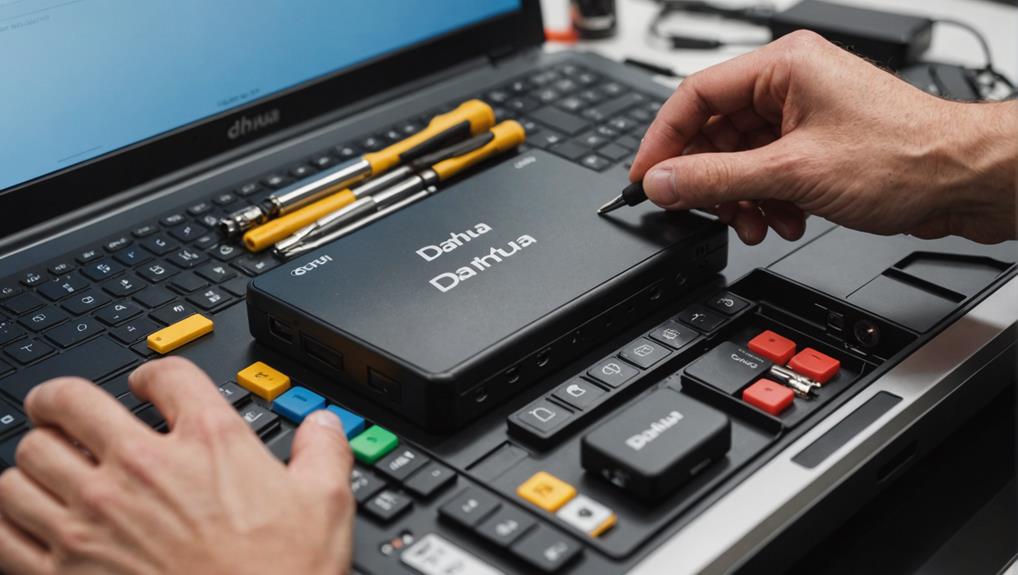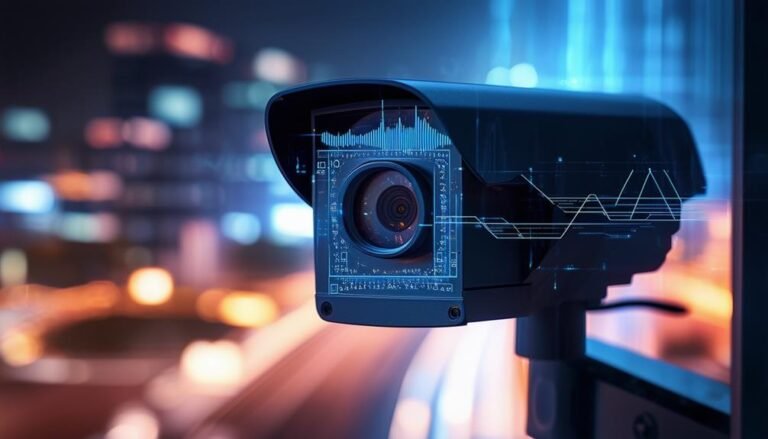To reset your Dahua DVR to factory default, start by accessing the home screen with your remote. Navigate to the “Menu,” and locate the System Settings icon, usually represented by a gear. Inside, find the Factory Reset option, ensuring you’re ready to lose all previous settings and data. Confirm the reset, then reboot the DVR by powering it off and on again after 10-15 seconds. After resetting, you’ll need to reconfigure your settings, including network and camera preferences. There are additional tips and tricks to streamline this process, so stick around for more insights.
Understanding Factory Reset
When it comes to troubleshooting your Dahua DVR, understanding the concept of a factory reset is vital. A factory reset fundamentally wipes the device clean, returning it to the state it was in when you first bought it. This means all your settings, configurations, and recorded data will be erased, so you’ll want to be certain this is the route you want to take.
You might be feeling frustrated with glitches or unresponsive features. A factory reset offers a fresh start, allowing you to regain control and, ultimately, freedom over your device. It’s like hitting the reset button on your life; it clears away the clutter and gives you the chance to rebuild your settings from the ground up.
Before you proceed, it’s important to understand that this isn’t a light decision. You’ll lose any customized settings and recordings you’ve saved. If you’re ready for a clean slate, make sure you’ve backed up any important data, if possible.
To execute a factory reset, you’ll typically access the settings menu on your DVR, but the exact steps can vary between models. Knowing how to perform the reset correctly is essential to avoid any further complications.
Ultimately, understanding a factory reset empowers you to take charge of your Dahua DVR, guaranteeing it operates efficiently and as you desire. Embrace the freedom that comes with a fresh start, and don’t hesitate to take the necessary steps to reclaim your device!
Reasons for Resetting
Several factors can lead you to contemplate resetting your Dahua DVR. One of the most common reasons is performance issues. If you notice lagging, freezing, or unresponsiveness, a reset might clear up those glitches and restore your device to its best condition. You deserve a DVR that runs smoothly, and sometimes a fresh start is all it needs.
Another reason you might consider resetting is if you’ve forgotten your login credentials. It’s frustrating not to access your own security footage, and a factory reset can help you regain control. By wiping the settings, you can start anew and set a password you won’t forget.
If you’ve recently moved your DVR to a new location or changed your home network, you might find that some settings no longer apply. Resetting your device can help it adapt to its new environment, allowing you to input the right configurations for seamless operation.
You might also find yourself resetting your DVR if you’re planning to sell or give it away. A factory reset guarantees that all your personal data and settings are wiped, giving the new owner a clean slate and protecting your privacy.
Lastly, if you’ve been experimenting with different settings or configurations and things have gone awry, a reset can bring everything back to the way it was intended to function. Embracing this freedom to start fresh can be just what you need to get your DVR working perfectly again.
Preparing Your DVR
Before diving into the reset process, it’s essential to prepare your DVR properly. This preparation guarantees you can reset your device smoothly and avoid unnecessary complications later on. Start by gathering all the necessary items, like your DVR unit, the remote control, and a backup storage device if you need to save any recordings.
Next, make certain your DVR is powered on and connected to a reliable power source. A power interruption during the reset can lead to further issues, so it’s best to avoid that. If your DVR is connected to a network, consider disconnecting it temporarily. This will help prevent any automatic updates or settings from interfering with the reset process.
It’s also wise to document your current settings before proceeding. Write down configurations like camera views, recording schedules, and any other specific preferences you’ve set. This way, you’ll have a reference point to restore your desired setup after the reset.
Lastly, confirm you’ve got the original installation manual or any documentation from the manufacturer. This can be handy if you encounter any uncertainties during the process.
Accessing the Menu
To access the menu on your Dahua DVR, start by using the remote control that came with your device. You’ll want to turn on your DVR and wait for the home screen to appear. Once it’s up, grab your remote and look for the “Menu” button, typically located near the center. Press that button, and you’ll be greeted with a series of options that give you the freedom to explore and configure your settings.
Navigating the menu is straightforward. Use the directional arrows on your remote to move up, down, or side to side. This allows you to scroll through various categories such as Live View, Playback, and Settings. Don’t hesitate to take your time; the options are designed to empower you to customize your experience fully. If you want to select a specific option, just press the “Enter” button, and you’ll dive deeper into that category.
If you ever feel lost or unsure, remember that you can always return to the main menu by pressing the “Menu” button again. This is your control center, where you can make adjustments according to your preferences. Whether you’re tweaking your camera angles or adjusting the recording settings, accessing this menu is your first step toward taking charge of your DVR. Enjoy the freedom to customize your surveillance system and make it work just the way you want!
Navigating to System Settings
Once you’re in the main menu, locating the System Settings is a breeze. Just take a moment to appreciate the simplicity of the interface. You’re on the verge of liberating your device from any settings that may be holding it back. To find the System Settings, look for an icon that resembles a gear or wrench—it’s often labeled clearly. With just a few clicks, you’re one step closer to taking control.
Here’s a handy table to keep you motivated as you navigate:
| Step | Action | Emotion |
|---|---|---|
| 1 | Access the main menu | Excitement |
| 2 | Spot the System Settings | Anticipation |
| 3 | Click on the settings icon | Empowerment |
| 4 | Explore available options | Curiosity |
| 5 | Prepare for changes | Freedom |
You’ll likely feel a rush of empowerment as you realize how easy it is to customize your DVR settings. Once you’re in the System Settings menu, you can see various options that allow you to tailor the device to your liking. This is your chance to reclaim control and guarantee your DVR operates the way you want it to.
Stay focused, and remember that every step you take in this process brings you closer to achieving the freedom you desire with your device. Embrace this journey!
Selecting Factory Reset Option
Having accessed the System Settings, you’re ready to take the next significant step: selecting the Factory Reset option. This is where you’ll reclaim control over your Dahua DVR. It is crucial to understand that this action will wipe all your previous settings and data, returning the device to its original state. If you’re looking for a fresh start, this is the way to go.
To find the Factory Reset option, navigate through the System Settings menu. Look for a tab labeled something like “Maintenance” or “Advanced Settings.” The exact wording might differ depending on your model, but it’s generally straightforward. Once you locate it, click on the Factory Reset option.
At this point, you might see a brief description of what the reset entails. This is your moment to pause and reflect. Are you genuinely ready to erase everything? If you’re sure, proceed with confidence. Selecting this option is your choice, and it can lead to a more streamlined experience if you’ve been struggling with previous settings.
Confirming the Reset
After selecting the Factory Reset option, you’ll need to confirm your decision to proceed. This step is essential because it guarantees you’re fully aware of the implications of resetting your Dahua DVR. It’s a chance to take control of your device and embrace a fresh start.
When confirming the reset, consider these key points:
- Data Loss: Understand that all recorded footage and customized settings will be erased. Make sure you’re okay with starting from scratch.
- Reconfiguration: After the reset, you’ll have to reconfigure your settings. This includes network settings, user accounts, and any other personalized configurations you previously set up.
- System Updates: Once you confirm the reset, check if your DVR needs any firmware updates. This is a good practice to guarantee your system runs smoothly and securely.
- Verification: Some models may require a verification code or password to finalize the reset. Be prepared to input this information as needed.
Rebooting the DVR
Rebooting your Dahua DVR is an important step in troubleshooting and can often resolve minor issues without needing a full reset. If your system’s acting up—like freezing, lagging, or not displaying video properly—rebooting might just do the trick. It’s a quick and easy fix that gives your DVR a fresh start.
To reboot your DVR, simply locate the power button on the device. You can usually find it on the front or rear panel. Press and hold it for a few seconds until the unit powers down. Once it’s off, wait about 10-15 seconds before turning it back on. This pause allows the system to clear its memory and reset any temporary glitches.
If you can’t find the power button, don’t worry! You can also unplug the DVR from the power source. Just make sure to wait a moment before plugging it back in. This method works just as effectively and is a good alternative if you prefer not to use the button.
After rebooting, give the DVR a moment to start up fully. Observe whether the issues you were experiencing have been resolved. This simple action can restore functionality without the hassle of a factory reset, which often requires reconfiguration of your settings. Embracing this quick fix can save you time and keep your DVR running smoothly, allowing you to enjoy your surveillance experience without interruptions.
Reconfiguring Your Settings
Often, you’ll need to reconfigure your settings after resetting your Dahua DVR to guarantee it operates according to your preferences. This is your chance to tailor the device to fit your needs, making sure you get the most out of your surveillance system. Here’s a straightforward guide to help you navigate this process effectively.
- Network Settings: Start by reconnecting your DVR to your network. Whether you’re using a wired or wireless connection, make certain that your device is set up to communicate seamlessly with your router.
- Camera Configuration: Adjust the settings for each camera. You can modify resolution, frame rate, and recording modes based on your security needs. Don’t forget to check the field of view to optimize coverage.
- User Management: Set up user accounts and permissions. This is essential for maintaining security. Create strong passwords and determine who can access the system and what level of control each user will have.
- Notification Settings: Finally, configure your alert preferences. Decide how and when you want to be notified of any unusual activity. This could be through email, app notifications, or SMS, depending on your comfort and needs.
Troubleshooting Post-Reset Issues
Once you’ve gone through the reset process, you might run into some hiccups that need addressing. These issues can often feel frustrating, but don’t worry; they’re usually easy to fix. Here’s a quick guide to help you navigate common post-reset problems with your Dahua DVR.
| Issue | Solution |
|---|---|
| No Video Output | Check the cables and connections. Verify the monitor is on the correct input. |
| DVR Won’t Connect to Network | Verify network settings and reconnect to your Wi-Fi or Ethernet. |
| Missing Recorded Footage | Double-check your storage settings. Verify your hard drive is correctly formatted and recognized. |
| User Interface Problems | Restart the DVR to refresh the system. If issues persist, consider a software update. |
| Error Messages on Screen | Look up the specific error code in the manual or online for precise troubleshooting steps. |
Frequently Asked Questions
Will a Factory Reset Delete All Recorded Videos?
When you perform a factory reset on your device, it typically wipes all settings and data, including recorded videos. So, if you’re looking to keep those recordings, it’s best to back them up before proceeding. A reset is a fresh start, but it comes at the cost of losing anything stored. If you value your footage, think twice and make sure you’ve saved what you want before hitting that reset button.
Can I Reset the DVR Remotely?
You might think resetting your DVR remotely is as easy as pie, but it can be a bit tricky. Most DVRs, including Dahua models, typically require physical access for a full factory reset. However, if you’ve set up remote management, you can access some settings. Just remember, this won’t always include a full reset. You’ll need to guarantee you’ve got your remote access configured correctly for a smoother experience!
How Long Does the Reset Process Take?
The reset process typically takes just a few minutes. Once you initiate the reset, you’ll notice the device rebooting, which can be a bit nerve-wracking. But don’t worry, after a short wait, it’ll return to its factory settings. Just make sure you’ve backed up any important footage beforehand, since this process wipes everything clean. So, grab a cup of coffee and let it do its thing!
Do I Need a Password to Reset the DVR?
Imagine you’re locked out of your favorite café, wishing to sip your morning brew. Resetting your DVR can feel the same—without the right password, you’re stuck outside. Yes, you do need the password to reset the DVR. It’s like having the key to that café; without it, you can’t enjoy the freedom of access. If you’ve forgotten it, you might need to contact support or consider a factory reset option.
What to Do if the Reset Option Is Greyed Out?
If the reset option‘s greyed out, it usually means you can’t access it due to user permissions or a restriction in the settings. First, check if you’re logged in with the admin account; only that can perform resets. If you’re still stuck, consider updating the firmware or contacting support for help. Sometimes, a simple reboot might also fix the issue, so don’t hesitate to try that first!



